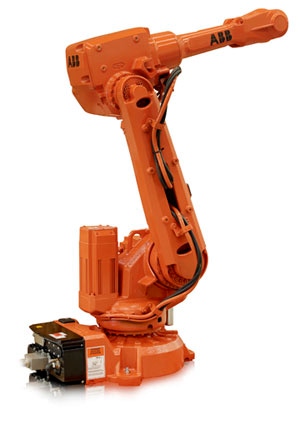Lighter, Quicker Robots Add Flexibility
December 15, 2010

ABBRobotics' latest family of medium capacity, multipurpose robotsfeatures an optimized compact design, an ultra-wide working range and a payloadcapacity up to 20 kg. The IRB-2600 also offers what ABB claims is the bestaccuracy and speed in its class, improving productivity through increasedoutput, faster cycle times and lower scrap rates.
"The release of the IRB 2600 is acontinuation of our philosophy of keeping footprint sizes smaller, armmechanisms scalable and control architecture powerful and flexible," says NickHunt, product support manager for ABB Robotics, North America. "This generationof robot arms replaces a similar arm payload range, but adds flexibility anddecreases physical size, while dramatically increasing the performancethroughout the entire work envelope."
Hunt says the key to increasing theIRB 2600 work envelope is in the unlinked revolute design compared to itsfour-bar linkage predecessor. For example, the IRB-2400 series robot it isreplacing uses a more constrained kinematic design. It can only move up andback as far as the parallel linkages allow, so the robot can't bend overbackwards.
"When we removed the constraint due to thefour-bar link, we also removed the motion constraint thereby increasing theuseable work envelope," says Hunt. "It virtually eliminates being limited toapproximately plus or minus 180 degrees for joint 1 or base movements."
Lighter, Quicker Robots Add Flexibility_360 |
Along with the design changes to the robot,ABB also increased the acceleration and speed of the joints, so the newIRB-2600 robots are not only quicker but also faster. The keys are both thehigh-speed motors and a lighter arm weight.
"Throughput is one of our primary designconsiderations, since advancing product through the process in the shortestpossible time is the production manager's chief goal," says Hunt. "When weincreased the acceleration for both joint and linear moves, increasedthroughput was the result."
The IRB 2600 is the second introduction ofABB's fourth-generation of midrange industrial robots, a portfolio redesignthat began with the 2009 introduction of the IRB 4600 family of robots in the20 to 60 kg payload range. At weights of 284 and 435 kg respectively for theheaviest models, the IRB 2600 and IRB 4600 are among the lightest robotsavailable in their payload ranges.
The IRB 2600 offers numerous system designand performance advantages including flexible mounting options that enableoptimized cell designs. The new robots can be floor, wall, invert orshelf-mounted which helps reduce floor space requirements and increases accessto the equipment being served. Wall-mounting is a new possibility for a robotof this size.
A key feature of the IRB 2600 is its compactand lightweight design, featuring a total arm weight of less than 300 kg andoccupying less floor space than any other robot in its class. Improved speedsand improved cycle times can improve production cycle times by up to 25 percent.High joint speeds and quick acceleration are achieved by combining lightweightmechanical linkages with patented QuickMoveTM motion control technology.
The IRB 2600 family contains three versions:two short arm variants (1.65m) for 12 or 20 kg payloads, and a long arm variant(1.85m) with a 12 kg payload. With the wrist vertical, up to a 27 kg payload isachievable for pick and place packaging applications.
"This is the second year in a row that ABBhas released a major addition to its product portfolio that shares the sameproven design principles," says Hunt. "That is a flexible control and softwarearchitecture for lower cost interface solutions, small mechanical footprint,high joint accelerations and lower power consumption per unit of payloadmass."
About the Author(s)
You May Also Like






